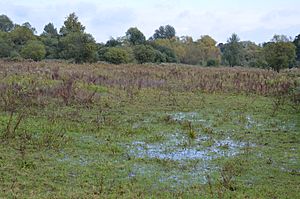Little Hallingbury Marsh facts for kids
| Site of Special Scientific Interest | |
 |
|
| Area of Search | Essex |
|---|---|
| Interest | Biological |
| Area | 4.5 hectares |
| Notification | 1990 |
| Location map | Magic Map |
Little Hallingbury Marsh is a special natural area in Essex, near the River Stort. It's about 4.5 hectares, which is roughly the size of six football fields! This marsh is officially known as a Site of Special Scientific Interest (SSSI). This means it's a protected place because it has rare plants, animals, or unique geology.
The marsh was recognized as an SSSI in 1990 under a law called the Wildlife and Countryside Act 1981. This law helps protect important natural spots across the UK. Even though it's a private area with no public paths directly through it, you can still get a good look at this amazing place from the River Stort towpath.
What Makes Little Hallingbury Marsh Special?
Little Hallingbury Marsh is a type of wetland called "unimproved wet grassland and fen." This means it's a natural, marshy area that hasn't been changed much by people. It's very wet and muddy, which is perfect for certain kinds of plants and animals.
Amazing Plants You Might Find
This marsh is home to some plants that are becoming quite rare. The wettest parts of the marsh are mostly covered by a plant called Reed Sweet-grass. This grass loves very wet soil and helps create a unique habitat. In the ditches that crisscross the marsh, you'll find branched reed-bur. These plants are important because they provide food and shelter for many creatures.
Wildlife of the Marsh
Little Hallingbury Marsh isn't just about plants; it's also a fantastic place for animals! Many different kinds of birds come here to spend the winter. They find plenty of food and a safe place to rest. The marsh is also a haven for aquatic insects, especially different types of dragonflies. These colorful insects zoom around the water, hunting other smaller bugs. They are a sign of a healthy wetland environment.

